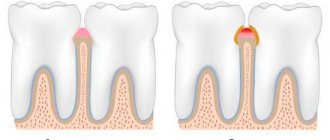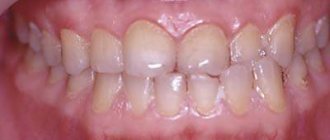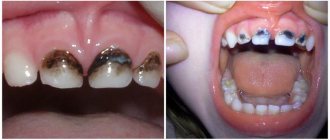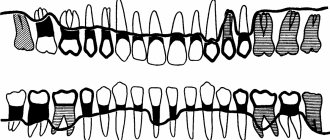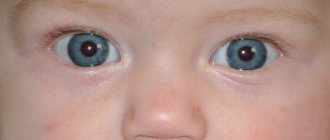Most people who do not have special knowledge in the field of dentistry believe that periodontitis is an inflammation of the gums. In fact, this is only partly true, since with this disease not only the gums become inflamed, but also the process of destruction of the periodontium begins - the tissues that fix the tooth in the bone. As a result, the tooth loses contact with the gum, and the patient can easily lose the tooth.
In children, periodontitis is diagnosed much less frequently than in adults, and has some differences in the nature of the disease.
Periodontitis in children: a mouth full of worries
Periodontitis is a disease in which all periodontal tissues become inflamed. Inflammation of the gums occurs, destruction of muscle ligaments, pathological periodontal (so-called periodontal) pockets are formed, the process affects the bone, then teeth begin to loosen and fall out.
Periodontitis in children is most often detected at the age of 9 - 10 years. And although this is not the most common dental disease, it occurs in only 3 - 5% of children, nothing guarantees that your child will not be affected by this problem.
The peculiarity of the course of periodontitis in children is that the inflammatory process affects functionally immature, growing, constantly remodeling tissues, which sometimes react inadequately even to minor damage.
In addition to the standard division according to prevalence into local and generalized, as well as into chronic and acute - according to the nature of its course, childhood periodontitis is divided into prepubertal and pubertal.
Periodontitis: bleeding gums and other symptoms
Among the common diseases of the oral cavity, dentists call periodontitis: what it is, you can look at the photo on the Internet, and at the same time find out what harm it causes to the teeth, how it is treated, etc. This diagnosis is made quite often. A doctor can diagnose the problem already at an initial consultation, but treatment and preventive measures are prescribed only after a thorough examination.
Periodontitis affects the soft tissue that surrounds the teeth. The tissues become inflamed and damaged, which causes discomfort to the person. You should consult a doctor at the first signs: the disease itself is not very pleasant, and its chronic form leads to serious consequences :
- bacterial tissue damage and the appearance of a periodontal pocket (at the junction of the tooth and gum);
- destruction of jaw bones, loosening and loss of teeth;
- chronic infection can harm the entire body: weakened immunity, joint diseases, rheumatism, etc.
At the first signs you should consult a doctor.
The initial appointment is one of the most important steps in treating periodontal disease. Whatever stage of development of gum disease you have, do not delay visiting the doctor. The sooner the work begins, the faster you will get rid of the unpleasant disease and prevent its consequences.
Is it possible to completely cure gum periodontitis and how? Here, much depends on the form and stage of the disease, as well as on the timeliness of contacting a specialist. In the early stages, achieving the desired result is quite possible.
Diagnosis of periodontitis
The “Good Dentist Clinic” offers comprehensive treatment of gums for periodontitis, which includes various methods of both the treatment program itself and its diagnosis.
Diagnostic procedures begin with an initial examination and also include measuring the depth of the gap between the teeth and gums to determine the form and stage of periodontitis. A periodontal sample may also be taken from the patient and other procedures may be performed.
When all the information has been collected, the doctor draws up a plan that decides how he will treat gum periodontitis (in children and adults): based on the causes, stage and symptoms, complex treatment is prescribed in several stages (drug and/or surgical methods) to prevent exacerbation and unpleasant consequences.
Contraindications for periodontitis
Contraindications are individual intolerance to the components of treatment, allergic reactions. Everything is determined in more detail at the initial stages of treatment.
Prevention of gum disease (periodontitis)
After completing the course of treatment and all operations performed, the doctor prescribes a set of preventive measures based on the stage and form of the disease. As a rule, the prevention of periodontitis includes taking a number of medications and carrying out special procedures for oral hygiene:
- regular rinsing with herbal infusions with an anti-inflammatory effect;
- regular applications of anti-inflammatory gel to the gums and use of anti-inflammatory mouth rinse;
- physiotherapy with the Darsenval apparatus;
- vacuum gum massage and hydromassage;
- brushing teeth with a properly selected paste, brush and floss - the selection should be made by the doctor, based on the condition of the patient’s teeth after treatment.
A well-chosen preventive program allows you to avoid relapse of the disease. All recommendations are given strictly individually.
Symptoms and signs of periodontitis
The disease has many different characteristic signs that make it possible to make an almost unmistakable diagnosis, but only a dentist will give complete confirmation. One of the first and most obvious signs is bleeding gums, which can be intermittent or constant, painful or not. You can notice this sign when brushing your teeth, eating solid food (biting an apple, for example). Sometimes the taste of blood in the mouth may appear spontaneously.
What other signs indicate dental periodontitis?
- Bad breath, which is difficult to suppress with any modern means.
- Loosening or displacement of teeth (indicates progression of the disease).
- In severe cases, the gums begin to swell and fester. This can lead to the formation of gumboil, or periodontal cyst.
- Soreness and discomfort in the gums.
- Tooth loss.
- Deterioration in health and general well-being (fever, fatigue, malaise, memory impairment, etc.).
If your gums are bleeding, it's time to make an appointment with your doctor. At the Good Dentist Clinic, specialists will conduct an examination, prescribe a diagnosis (if necessary) and draw up a treatment plan.
Periodontitis: causes of the disease
The appearance and development of the disease is caused by:
- improper or insufficient oral hygiene;
- the presence of subgingival tartar, which threatens the health of the gums and the entire oral cavity;
- poorly installed fillings or dentures, unprofessionally performed restoration, filling material getting into the interdental space, etc.;
- malocclusion, dental anomalies, incorrect position of teeth, etc.;
- some common diseases: gastrointestinal problems, hormonal disorders, cardiovascular diseases, etc.
What is the difference between periodontitis and periodontal disease?
Both periodontitis and periodontal disease are diseases that affect the periodontium (the tissue that supports the tooth). The difference between these diseases is significant :
- Periodontitis is an inflammatory disease of the gums (periodontal tissue), which is characterized by bleeding, etc. It occurs very often in many adults. Affects either individual areas of the jaw or all teeth;
- Periodontal disease is a systemic periodontal disease that manifests itself in the form of tissue atrophy (tooth cells). It is extremely rare. It affects all teeth of the upper and lower jaws, and there is practically no bleeding.
A more detailed answer in your specific situation can be obtained at a consultation with specialists from the “Good Dentist Clinic” in St. Petersburg and you can find out the exact prices for modern medicinal and therapeutic treatment of various forms of periodontitis (acute generalized, chronic, baby teeth in a child),
Classification of periodontitis
Gum inflammation is classified according to three parameters (minimum), each of which has its own characteristics and characteristics that help determine how severe the gum damage is.
By process diffusion
- Localized periodontitis
The inflammatory process occurs in individual areas (in the area of one or more teeth). Localized periodontitis occurs as a result of trauma, for example, with an oversized filling or an incorrectly installed prosthesis. Most often it begins suddenly and with rapidly manifesting clinical symptoms.
- Generalized periodontitis
It is also called diffuse, and it is characterized by damage to almost all teeth in a row or in the entire jaw. The emergence and development of generalized periodontitis occurs as a result of bacterial damage. It is mostly asymptomatic and painless, most often taking a chronic form.
By severity
- Mild periodontitis
At this degree, the tooth root is exposed a little, and a small periodontal pocket (up to 3.5 mm) is formed, which is detected upon examination. The teeth remain motionless.
- Moderate periodontitis
The periodontal pocket reaches 5 mm, the tooth root is half exposed. Also, a distinctive feature of this stage is slight mobility of the teeth.
- Severe degree
It is characterized by a large depth of pockets (more than 5 mm), with significant exposure of the root, and the teeth are very loose.
According to the process
- Acute form
The acute form is characterized by sudden sharp pain, bleeding gums, swelling, purulent discharge, etc.
- Chronic form
The inflammatory process in periodontal tissues occurs constantly, but is cyclical in nature, that is, there is a change in relapses and remissions of periodontitis. At the same time, the chronic form also has its own subcategories or forms with characteristic features:
- Chronic generalized periodontitis
It affects all or almost all periodontal tissues and is characterized by a change in conditions (relapses and remissions) and manifestations of clinical signs.
- Purulent form
A pathological form, when there are already significant sized gum pockets where purulent discharge accumulates. This form cannot be allowed to develop; it can lead to the development of an abscess.
- Abscess form
This is the very stage when a serious complication appears in the form of an abscess (purulent focus). For any form and individual characteristics of the patient, its own form of treatment is selected.
Surgical methods of treatment
After examination and diagnosis, the doctor comes up with a treatment plan, which may include surgery.
- Closed curettage
Closed curettage of periodontal pockets is a procedure that involves using special dental instruments to remove all deposits (plaque or tartar) that have accumulated under the gums. The peculiarity of closed curettage is that it is performed without cutting the gums.
- Open curettage
To perform an open operation, the doctor must determine the depth of the resulting pockets. If the pockets exceed 1-2 mm, then food debris accumulates in them and cannot be cleaned out yourself, which means that there is an ideal place for the development of microbes. Only open curettage will allow you to completely clean the periodontal gum pocket.
- Flap operations
This is a surgical procedure, the main purpose of which is to clean the pockets as with curettage, as well as to reduce them. Flap surgery for periodontitis is performed under local anesthesia and involves a vertical incision in the gum followed by the formation of a flap.
The doctor cleans all deposits under the gum and sometimes performs bone grafting. When the operation is completed, the doctor sutures the flap and applies a special bandage.
Dental implantation for periodontitis
Installing implants is one possible solution to the problem, but it must be carefully considered. First of all, the possibility of using the implantation method depends on the individual case.
What are the benefits of dental implantation for periodontitis? The operation allows you to stop further development and worsening of the situation. It is carried out only at the stage of remission of periodontitis, and only after consultation and examination of the patient by several specialists (periodontist, orthopedist, implantologist, etc.).
Dental prosthetics for periodontitis
Prosthetics must be carefully prepared depending on the individual characteristics of each specific situation. It makes it possible to preserve teeth if they are healthy and strengthen them if they are loose.
Periodontitis in children
The pediatric form of the disease is much less common than the adult form, and most often these are patients aged 9–10 years. Periodontitis in children is an inflammation of those areas of the gums where tissue restructuring and development is still underway.
Any, even minor damage to such periodontal tissue can lead to the development of the disease. Periodontitis in children occurs in different forms. For example, in chronic or acute, and also has its own classification - prepubertal and pubertal.
Periodontitis during pregnancy
Periodontal inflammation occurs quite often in pregnant women. Lack of treatment for periodontitis during pregnancy leads to serious complications not only for the teeth and gums, but also for the entire body of the expectant mother as a whole, which can affect the child. If this diagnosis has been made, then treatment is carried out taking into account all the individual characteristics of the patient and the course of pregnancy. If there are no problems, then expectant mothers need to be very careful about preventing the disease.
Prepubertal periodontitis
It begins during the eruption of baby teeth or immediately upon its completion. It is characterized by disruption of the connection between the gum and tooth and serious destruction (change in structure) of the bone. Prepubertal periodontitis already at a very early age leads to the loss of a large number of baby teeth, after which the inflammatory process spreads to the rudiments of permanent teeth. The causes of the development of prepubertal periodontitis are most often weakened immunity, as well as the presence in the child’s oral cavity of specific types of microorganisms, the original carriers of which in most cases are the baby’s parents.
Gum atrophy
A rather unique and rare disease - gum atrophy or exposing atrophic gingivitis manifests itself as itching in the area of 2, less often 4 and 6 symmetrically located milk teeth. A child experiencing discomfort constantly rubs the area of inflammation. At night, the itching usually intensifies.
The interdental papillae and other areas of the gums do not change in any way during gingival atrophy. Slight deposits of tartar are often observed on the unprotected root surface.
The manifestation of itching can be a consequence of measles or influenza, despite the fact that in most young patients such a relationship is not observed. The process of teething is also one of the factors causing itching in infants.
Local factors
Insufficient level of oral hygiene
The inability to properly brush your teeth with a special children's toothbrush and the reluctance to regularly carry out hygiene procedures lead to the accumulation of microorganisms in the periodontal pockets, and the toxins they release trigger the inflammatory process.
Short frenulum of the tongue or lip
Insufficiently long frenulums provoke atrophy and inflammation of the adjacent gum area due to constant tension on the frenulum fibers. The inflammatory process is localized in the area of the lower central teeth.
Chewing food on one side
The habit of chewing food on one side is fraught with the accumulation of plaque on teeth that are not involved in chewing. It is necessary to explain to the child that food should be chewed on both the left and right sides.
Anomalies and deformations of the dental system
The development of the inflammatory process in periodontal tissues can be caused by both functional overload of certain teeth and insufficient load on them. The reason for this is an incorrect bite or an incomplete set of teeth (the permanent teeth have not yet grown in, and some of the baby teeth have already fallen out).
Gum injuries
This group of factors that provoke the occurrence and development of periodontitis includes chronic trauma to the gums from decayed teeth or parts of braces, as well as filling defects and damage to periodontal tissue by nails, pens, and hair clips.
Nutritional nature
Too soft food does not contribute to a sufficient load on the child’s chewing apparatus and self-cleaning of the teeth, which results in the accumulation of plaque at their base, and as a result, the appearance of tartar in children.
Preventive actions
The best prevention of inflammation of the mucous membrane is daily and high-quality hygiene from an early age and proper nutrition.
Hygiene
The concept of “quality hygiene” includes brushing your teeth at least twice: in the morning and in the evening, in conjunction with cleaning the palate and tongue.
Parents should take a very responsible approach to hygiene from the day the first tooth appears. And after he grows up a little, learn the rules of brushing his teeth: regularly and efficiently. The toothbrush and toothpaste should be selected according to the age of the small patient.
Nutrition
In addition to hygiene, parents need to approach the diet wisely: it should be balanced and include vitamins and minerals. Sweets and carbonated drinks should be consumed by the child in limited quantities. In addition, after finishing eating sweets, the baby should rinse his mouth with water and, if possible, brush his teeth. Note that a diet that promotes the proper development of a growing body includes nutritious and timely meals. Snacking and disordered eating should be kept to a minimum.
Treatment of periodontitis in children: the work of professionals
Non-surgical methods for treating the inflammatory process of periodontal tissue are the same as in adults.
This includes professional oral hygiene and various physiotherapeutic procedures. Surgical interventions, such as lip frenulum correction, may also be required. In any case, before prescribing certain procedures, a child must visit pediatric dentistry for consultation with three specialists - a therapist, a surgeon and an orthodontist. They will determine the true causes of periodontitis and develop an individual treatment plan. It is also important to exclude systemic diseases that can provoke periodontitis. Their treatment must be carried out with the participation of a specialist of the appropriate profile.
You should contact a periodontist as soon as possible if:
- When brushing your teeth or chewing, you feel pain in your gums;
- traces of blood are visible on the toothbrush or hard bitten foods;
- there is redness and swelling of soft tissues;
- a specific odor has appeared from the mouth, which disappears for some time after hygiene procedures.
Experienced doctors provide consultations at Ultramed Family Dentistry. Thanks to modern dental equipment, specialists will identify the cause of the disease and, accordingly, prescribe the most effective treatment method.
Prevention of periodontal diseases
The main means of preventing any diseases of the oral cavity is high-quality and proper hygiene, which includes:
- brushing your teeth at least 2 times a day;
- using dental floss to remove plaque and food debris from hard-to-reach places;
- using mouth rinses.
Also important are regular preventive examinations of the oral cavity by a dentist, professional hygienic teeth cleaning (at least 2 times a year), proper nutrition with a sufficient supply of vitamins and minerals, timely and high-quality treatment of infectious and chronic diseases that lead to periodontal diseases. It is important to remember that the prognosis of treatment will largely depend on the stage of the disease. Observation by a specialist is especially important if there is a hereditary predisposition to this pathology.
The multidisciplinary clinic “Medical Collegium” provides all types of services for comprehensive diagnosis and treatment of periodontal tissue. The clinic's specialists in the field of periodontology provide therapeutic and surgical treatment of various diseases of the periodontal tissues. You can make an appointment with a periodontist by phone.
